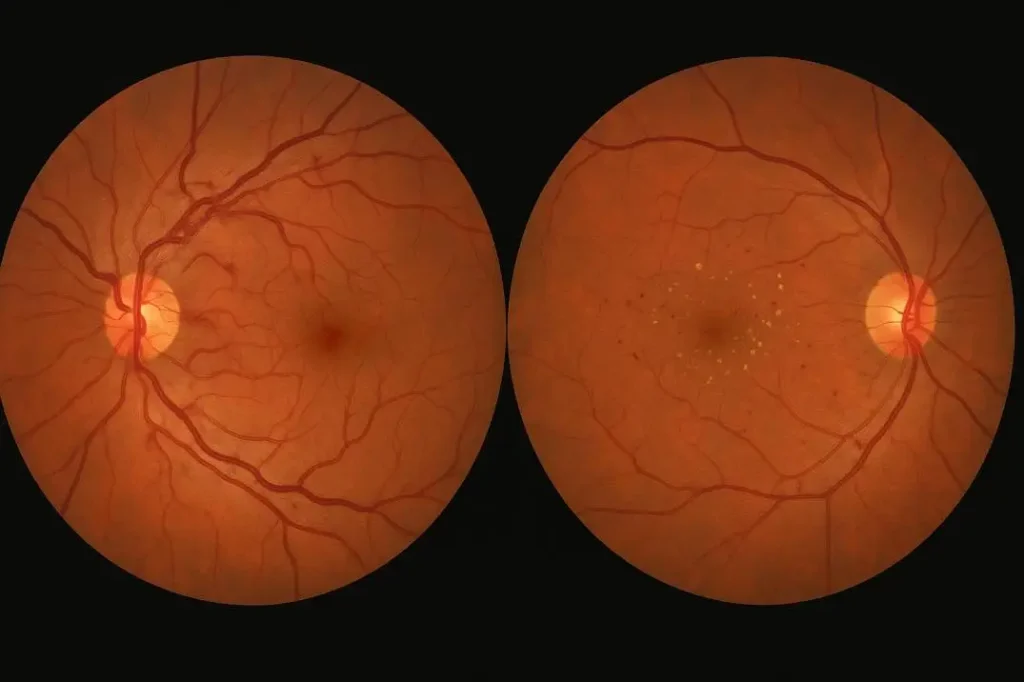Understanding the Differences Between Proliferative and Non-Proliferative Diabetic Retinopathy
Diabetic retinopathy is a concerning complication faced by individuals living with diabetes, often turning daily life into a struggle with vision issues. But what does this condition entail, and why are its two stages, proliferative and non-proliferative diabetic retinopathy (PDR and NPDR), so important to understand?
This guide is your comprehensive resource for navigating the differences between these stages, their symptoms, and how to manage and prevent them.

AUTHOR
Ophthalmologist/ Eye Surgeon 13+ Years Exp
MBBS, MS – Ophthalmology
TSMC- TSMC/FMR/05251 (2018)
CONDITION
CALL US 24/7 FOR ANY HELP
GET IN TOUCH ON
What is Diabetic Retinopathy?
Diabetic retinopathy is one of the most common complications of diabetes, affecting the eyes. High blood sugar levels damage the tiny blood vessels in the retina, the part of the eye that senses light and sends signals to the brain. This condition progresses gradually and, if left untreated, can lead to significant vision loss or blindness.
There are two primary stages:
- Non-Proliferative Diabetic Retinopathy (NPDR): The initial stage characterized by damaged retinal blood vessels that leak, causing swelling or the buildup of fluid in the retina.
- Proliferative Diabetic Retinopathy (PDR): An advanced stage marked by the abnormal growth of new, fragile blood vessels in the retina, leading to severe complications like bleeding, retinal detachment, and vision loss.
According to the World Health Organization (WHO), approximately one-third of people with diabetes show signs of diabetic retinopathy.
Differences Between Proliferative and Non-Proliferative Diabetic Retinopathy
Understanding the difference between NPDR and PDR is essential for timely diagnosis and intervention. Here’s a side-by-side comparison:
Feature | Non-Proliferative Diabetic Retinopathy (NPDR) | Proliferative Diabetic Retinopathy (PDR) |
Stage | Early stage | Advanced stage |
Key Characteristic | Blood vessels leak fluid into the retina | Growth of new, abnormal blood vessels (neovascularization) |
Symptoms | Often asymptomatic in early stages; blurry vision may develop | Sudden vision changes, significant floaters, and vitreous hemorrhage |
Complications | Macular edema and mild vision distortion | Retinal detachment, severe bleeding, blindness |
Progression Speed | Gradual | Rapid |
Treatment Needs | Monitoring and controlling blood sugar levels | Laser therapy, injections, or surgery often required |
NPDR primarily involves damaged blood vessels, while PDR introduces the critical issue of neovascularization, increasing the stakes for timely treatment.
Symptoms and Diagnosis
⇒Symptoms of NPDR
- Blurred or fluctuating vision
- Dark spots or floaters in your vision
- Difficulty distinguishing colors
- Areas of vision loss or distortion (macular edema)
⇒Symptoms of PDR
- Significant floaters or flashes of light
- Sudden or severe loss of vision
- Persistent eye pain or pressure
- Complete vision blackouts due to bleeding (vitreous hemorrhage)
⇒Diagnostic Procedures
To diagnose diabetic retinopathy, eye specialists use:
- Dilated Eye Exam: Enables detailed examination of the retina and blood vessels.
- Fluorescein Angiography: A dye test to detect abnormalities in blood vessels.
- Optical Coherence Tomography (OCT): Provides detailed cross-sectional images of the retina, identifying swelling or fluid buildup.
Early diagnosis through routine eye exams can prevent disease progression. The American Academy of Ophthalmology recommends annual eye screenings for diabetic patients.
Causes and Risk Factors
⇒Causes
Diabetic retinopathy is caused by prolonged periods of high blood sugar. Over time, excess glucose damages the retina’s blood vessels, leading to leaking, swelling, and blockage.
⇒Major Risk Factors
- Poorly managed blood sugar levels
- Long duration of diabetes
- High blood pressure or cholesterol
- Smoking
- Pregnancy (gestational diabetes can exacerbate retinopathy)
Treatment Options for NPDR and PDR
Treatment approaches vary depending on the stage of diabetic retinopathy:
⇒Non-Proliferative Diabetic Retinopathy
- Blood Sugar and Blood Pressure Control: A critical step in preventing disease progression.
- Close Monitoring: Regular eye exams help track changes in the retina.
⇒Proliferative Diabetic Retinopathy
- Anti-VEGF Therapy: Medications like Ranibizumab are injected into the eye to inhibit abnormal blood vessel growth.
- Panretinal Photocoagulation (Laser Therapy): Seals leaks in blood vessels and shrinks abnormal vessels to preserve vision.
- Vitrectomy: A surgical procedure to remove blood or scar tissue from the eye.
Advances in laser technology and injectable medications have significantly improved outcomes, especially for PDR.
Prevention Strategies and Lifestyle Tips
Preventing diabetic retinopathy starts with effective diabetes management. Here are tips to safeguard your vision:
- Control Blood Sugar Levels: Aim to maintain an HbA1c level below 7%.
- Monitor Blood Pressure and Cholesterol: High blood pressure exacerbates eye diseases.
- Quit Smoking: Smoking accelerates the damage to blood vessels.
- Regular Eye Exams: Annual screenings catch signs of retinopathy early. Those with NPDR or PDR may require more frequent visits.
- Adopt a Healthy Lifestyle: Exercise regularly, maintain a balanced diet, and manage stress.
⇒Foods That Support Eye Health
- Spinach, kale, and other dark leafy greens
- Citrus fruits rich in Vitamin C
- Omega-3-rich foods like salmon and walnuts
FAQs
1. Can diabetic retinopathy cause blindness?
Yes, untreated diabetic retinopathy can result in blindness. PDR, the advanced stage, poses the highest risk.
2. Is diabetic retinopathy reversible?
While early changes in NPDR can improve with good blood sugar control, advanced damage in PDR usually requires medical intervention.
3. How often should I get an eye exam if I have diabetes?
Annual comprehensive eye exams are recommended. If you’re diagnosed with retinopathy, your doctor may suggest more frequent screenings.
4. What are the warning signs of severe diabetic retinopathy?
Sudden vision loss, significant floaters, or flashes of light signal urgent care needs.
5. Can children with diabetes develop retinopathy?
Yes, while rarer, children with type 1 or type 2 diabetes are at risk, particularly if their diabetes is poorly managed.
Summary and Key Takeaways
Diabetic retinopathy is a serious yet manageable condition. Understanding the differences between NPDR and PDR equips patients to take timely, informed action. Key points include:
- Managing blood sugar, blood pressure, and cholesterol is critical to prevention.
- NPDR progresses slowly, while PDR can lead to rapid vision loss.
- Treatment options range from routine monitoring in early stages to anti-VEGF injections or surgery for advanced cases.
- Consistent eye exams are your best defense.
⇒Call to Action
If you or a loved one has diabetes, schedule a comprehensive eye examination today. Early detection and proactive care can preserve your vision and protect your quality of life.
Take this opportunity to manage your health effectively and consult an eye specialist to secure your vision for the future.
Appointment Form
AUTHOR
Ophthalmologist/ Eye Surgeon 13+ Years Exp
MBBS, MS – Ophthalmology
TSMC- TSMC/FMR/05251 (2018)
CONDITION
CALL US 24/7 FOR ANY HELP
GET IN TOUCH ON
Appointment Form
About Us
Saijyothi Eye Hospital, where excellence meets compassion. Founded by the esteemed Dr. Saibaba Goud, M.S., Ph.D., Padma Shri Awardee, our institution stands as a beacon of hope for those seeking exceptional eye care. Dr. Saibaba Goud’s vision goes beyond restoring sight, aiming to transform lives. At Saijyothi Eye Hospital, we offer exceptional care, from routine eye exams to advanced surgeries, with personalized services tailored to each patient’s needs.
Our Locations:
West Marredpally
- Plot No 185, Road No 1 Beside Kennedy School, Opposite lane to Om Shanthi Foods, West Marredpally, Secunderabad-500026.
Kompally
- 3rd Floor, Vaishnavi Lemini Arcade, Doolapally Road, Above Ratnadeep Super Market, Devender Colony, Kompally, Hyderabad, Telangana 500014
Uppal
- D.No. 2-2-15, Hanuma Sai Nagar, Uppal X Roads, Near Gandhi Statue Centre, Uppal, Hyderabad, Telangana 500039

